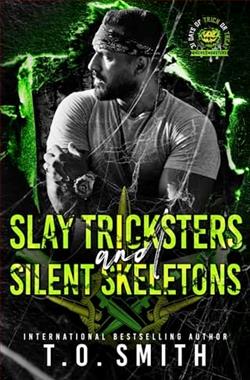Page 46 of The Texas Murders
Frank shows us Chipeta’s bedroom, which he says he hasn’t touched since her disappearance. There are posters of bands, shelves full of books, a closet of dresses and shoes. There are plenty of examples of artwork—paintings, pottery, beaded blankets—that are good but don’t seem quite as professionally polished as what we saw in the living room. Frank confirms my suspicion that these were created by Chipeta.
I look around, then stop to pay particular attention to a display of photographs of the girl with friends. Some show Chipeta dressed in Native regalia, clearly taken at powwows or festivals. Others show her hiking or skiing or dressed for a high school dance, some of these with Native friends but others with white and Latina girls.
“In one of the police photographs,” Ava says to Frank, “there was a picture of an eagle feather. Does this ring a bell?”
Frank has a puzzled look on his face, then he seems to remember.
“When I say I haven’t touched anything, that’s not entirely true,” he says, opening the closet door and pulling out a box. “I did clean up. My daughter didn’t always keep her room tidy.”
I recall the crime scene photos and remember that the room did look a bit messier than it does now. Frank opens the box and rummages around inside. He stands up holding an eagle feather by the quill.
“Is this what you’re looking for?” he asks.
CHAPTER 38
LATER THAT AFTERNOON, Ava and I get on a Zoom call with Carlos to discuss what we’ve found out so far. We’re sitting on a balcony where we rented rooms at Purgatory Resort, which is a ski resort in the winter and is open in the summer for activities like mountain biking and ropes courses for kids. My laptop is open on a chair, facing Ava and me. Behind the computer, the view is spectacular, with mountains all around, the tallest in the distance still capped with snow.
Through a pixelated image on my laptop, Carlos explains that the woman he’s researching, Tina White Wolf, was by all accounts a troublemaker. Both her mother and father, who are divorced, agreed on this. She had been suspended from school more than once growing up, had been arrested a few times for shoplifting and underage drinking, and had failed out of community college shortly before her disappearance.
“Everyone says she was charismatic and fun to be around. A natural leader. But,” Carlos adds, “she seemed to be drawn to trouble, like a moth to flame.”
The parents said that sometimes she would take off for a few days without telling anyone where she was going, which is why they initially weren’t concerned by her disappearance. The father, Carlos explains, had always feared he would lose his daughter to serious drugs or serious crimes, and when she disappeared, he worried that his fears had finally come true. But as the days passed and there was still no word from her, the mother felt certain something else was wrong.
“Her mom says Tina had never gone a week without at least checking in,” Carlos explains. “As much trouble as she was, she never wanted her mom to worry—at least not for long.”
Ava points out that it’s interesting how different the girls were. They came from different tribes and different areas of the Southwest. Some grew up on reservations, some didn’t. They also came from different socioeconomic backgrounds: some well off; some quite poor.
“The only thing these girls had in common,” Ava says, “was they were young, pretty, and Indian.”
“I don’t know,” Carlos says. “There’s something else about them, too. They all excelled at something. You said Chipeta was an artist. Well, Tina was apparently an excellent drummer. Despite her troubles growing up, she always competed at festivals. Didn’t one of the girls have a bunch of ribbons from dancing competitions?”
After some discussion, we determine that each of the fourvictims had a special interest when it came to exploring her Native American heritage. But Ava points out that we could find that in any young woman. Her interests might be soccer or piano or playing video games, instead of dancing or drumming, but still any missing woman would have passions that she was good at.
“You’re probably right,” Carlos concedes, “but I feel like there’s something here we’re just not quite getting.”
Carlos also obtained the golden eagle feather found at the scene, which the Houston police had in an evidence locker. He holds it up encased in a plastic bag.
“Looks just like the others,” he says.
“Ours, too,” I say, holding up the one Frank Tavaci gave us, also in an evidence bag.
When he gave it to us, the girl’s father explained that he couldn’t remember seeing it in the house prior to her disappearance, but hadn’t thought much of it when he found it while cleaning her room. Chipeta was artistic—she was good at beadwork, pottery, any type of arts and crafts. He assumed she’d picked it up somewhere with plans to make something with it.
“Any word about the DNA tests on the other feathers?” Carlos asks me.
“No. I asked the lab to give them priority, but I haven’t heard anything. I’ll check right now.”
Carlos and Ava keep talking, and I step inside my hotel room and dial the crime lab. I give the tech who answers the phone the file number and wait.
“It’s supposed to be fast-tracked,” I explain.
That’s one of the benefits of being a Texas Ranger. When you send something to the crime lab, you can ask for it to be prioritized. Otherwise, getting results could take months. It’s a privilege I don’t like to use unless it’s important.
“This is part of the whole FBI Native American task force, isn’t it?” the technician asks. After a few more moments, in which I can hear keys typing on a computer, the tech says, “Looks here like Agent Logan took it off the priority list.”
“What?”
I guess the FBI’s priority supersedes the Texas Rangers’.















